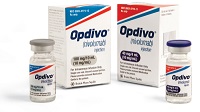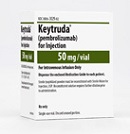 Kidney cancer triggered lots of buzz at the European Cancer Congress over the weekend, no doubt. But the head-to-head lung cancer battle between Merck & Co.'s ($MRK) Keytruda and Bristol-Myers Squibb's ($BMY) Opdivo is still the hottest ticket in the PD-1/PD-L1 field.
Kidney cancer triggered lots of buzz at the European Cancer Congress over the weekend, no doubt. But the head-to-head lung cancer battle between Merck & Co.'s ($MRK) Keytruda and Bristol-Myers Squibb's ($BMY) Opdivo is still the hottest ticket in the PD-1/PD-L1 field.
Lung cancer is, after all, the most common form of the disease worldwide and second in line in the U.S., with 221,000 new cases expected to be diagnosed this year, according to the National Cancer Institute. Estimated market size? $10 billion. And so far, Keytruda and Opdivo have been mostly neck-and-neck; Bristol-Myers nabbed the first approval in the squamous form of the disease early this year, but Merck is poised for dual FDA nods next month in squamous and non-squamous NSCLC.
But as Bernstein & Co. analyst Tim Anderson points out, market-watchers have repeatedly pegged Opdivo as the putative winner in the field, with sales estimates that far outpace Keytruda's. In lung cancer, that case is based on predictions that Opdivo will have a broad label for second-line use, with FDA backing in all forms of the disease, regardless of whether patients test positive for the PDL1 biomarker targeted by the med. Keytruda's label, by contrast, could well be much narrower, limited to patients expressing PDL1--and probably only "high expressions," Anderson notes.
 But that may not make a major difference, marketing-wise, Anderson figures. Though Merck "seems destined to have a 'narrow' label," he wrote in a recent investor note, "This near-term label decision may not matter as much as investors think."
But that may not make a major difference, marketing-wise, Anderson figures. Though Merck "seems destined to have a 'narrow' label," he wrote in a recent investor note, "This near-term label decision may not matter as much as investors think."
That's partly because treatment decisions in oncology don't just depend on FDA labeling. The National Cancer Care Network (NCCN) publishes an influential compendia of recommendations about cancer treatment, and Medicare is required to cover NCCN-recommended meds, regardless of their FDA labels. If Keytruda gets an NCCN rec for broad use, then the label won't be as important--and as Anderson points out, the average age of lung cancer diagnosis is 65, i.e., the age at which Medicare coverage begins.
Plus, the "narrow" label would only apply in patients who've been treated with another drug regimen already--and for now, that's the only FDA approval either drug is ready for. In previously untreated patients--for first-line use--Bristol-Myers and Merck are testing their meds in similar trials, looking only at patients who test positive for the biomarker.
So, Opdivo could lose its labeling advantage when and if both meds are approved for first-line use. And there are about twice as many newly diagnosed lung cancer patients as there are those who've been treated at least once already, Anderson says.
And overseas, the difference may be moot, because payers will be looking to limit these expensive drugs as much as possible, and are likely to reserve them only for biomarker-positive patients in any case, he says.
We'll get a better idea of how the commercial battle stacks up after Keytruda gets its FDA news Oct. 6--and an even better one in January, when the verdict on Opdivo in non-squamous NSCLC is forthcoming. But Roche ($RHHBY) could quickly come in and complicate matters; its atezolizumab is coming on strong with a "breakthrough" designation in lung cancer and potential approval next year.
- see the latest Opdivo data
Special Reports: Top 15 pharma companies by 2014 revenue - Merck - Bristol-Myers Squibb | Top 10 best-selling cancer drugs of 2013